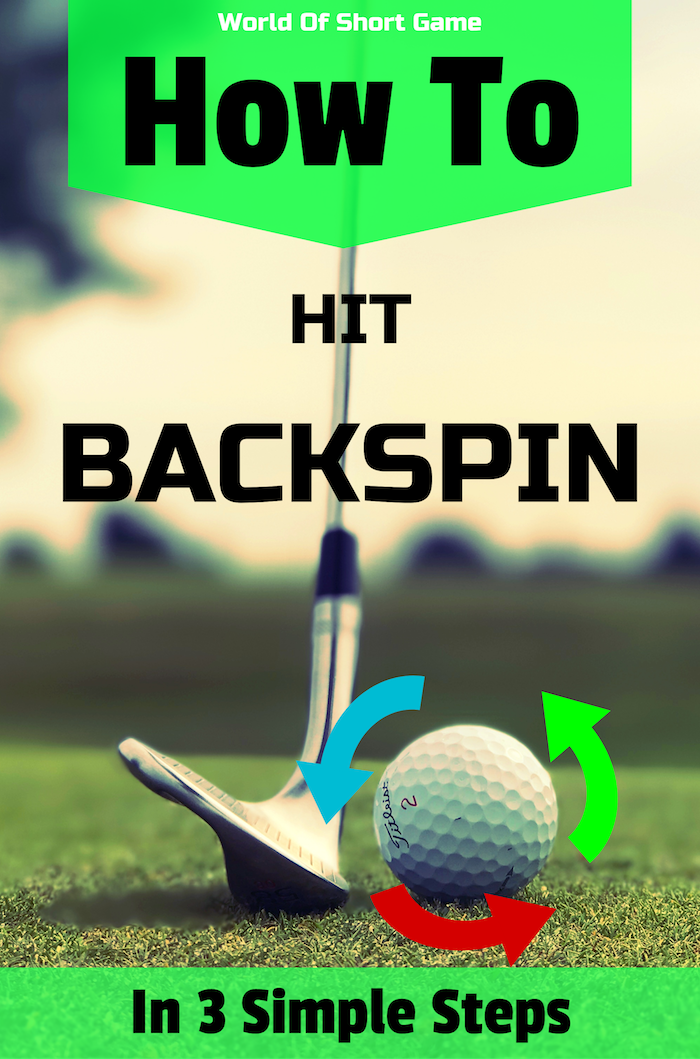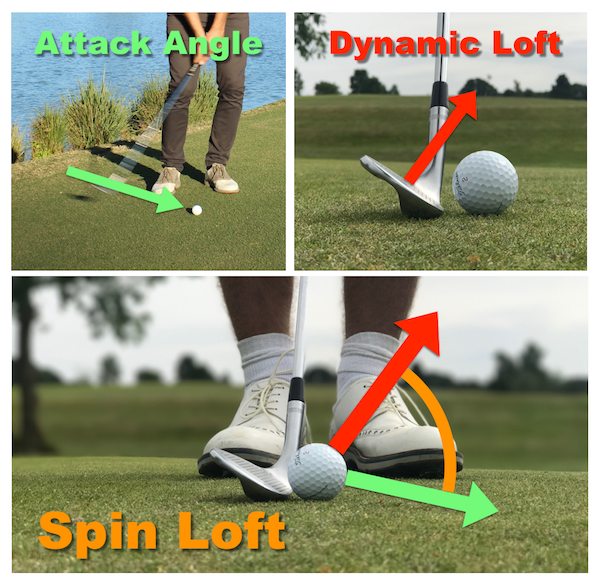To put backspin on a golf ball, strike it with a downward angle and make clean contact with the clubface. Ensure your clubface is lofted and your swing speed is high.
Backspin can significantly improve your golf game by adding control and distance to your shots. Achieving backspin involves precise techniques and proper equipment. A downward strike on the ball with a clean, lofted clubface helps generate the necessary spin. Swing speed also plays a crucial role; faster swings typically produce more backspin.
Practice these methods to enhance your overall performance on the golf course. Using quality golf balls and clubs designed for spin can further improve your results. Mastering backspin can give you a competitive edge in your game.

Credit: www.worldofshortgame.com
Basics Of Backspin
Understanding how to put backspin on a golf ball can significantly improve your game. Backspin helps control the ball’s flight and landing. Let’s dive into the basics of backspin and why it matters.
What Is Backspin?
Backspin is the backward rotation of the golf ball. This rotation occurs when the ball makes contact with the clubface, especially a wedge or iron. The friction between the clubface and ball creates this spin.
When the ball has backspin, it rises higher and lands more softly. This makes it easier to control where the ball stops on the green.
Importance Of Backspin
Backspin is crucial for several reasons:
- Control: Helps in controlling the ball’s stopping point.
- Height: Makes the ball rise higher, avoiding obstacles.
- Soft Landing: Ensures the ball lands softly on the green.
| Benefit | Description |
|---|---|
| Control | Improves accuracy of shots |
| Height | Helps clear hazards |
| Soft Landing | Prevents ball from rolling off the green |
Mastering backspin can greatly enhance your performance. It allows for more precise shots and better scorecards.

Credit: www.worldofshortgame.com
Choosing The Right Equipment
Getting the perfect backspin on a golf ball requires more than just skill. Your equipment plays a crucial role. The right clubs and balls are essential for achieving that perfect backspin. Let’s dive into the specifics of what you need.
Golf Clubs
Selecting the right golf club is the first step. Here’s what to look for:
- Loft: Higher loft clubs, like wedges, are best for backspin.
- Grooves: Clubs with sharp, clean grooves grip the ball better.
- Shaft Flex: Choose a shaft that matches your swing speed.
Wedges with more loft, around 56° to 60°, help generate more spin. Clean grooves ensure maximum contact with the ball’s surface. The right shaft flex can improve your control and accuracy.
Golf Balls
The type of golf ball you use also impacts backspin. Here are key features to consider:
- Cover Material: Urethane covers offer more spin control.
- Compression: Lower compression balls can generate more spin.
- Dimples: More dimples mean better aerodynamics and spin.
Urethane-covered balls provide a soft feel and better spin control. Low compression balls compress more on impact, creating more spin. Balls with many dimples are more aerodynamic, aiding in better spin and control.
Proper Grip And Stance
Mastering the proper grip and stance is essential for putting backspin on a golf ball. These foundational elements help you control the ball’s spin, leading to more precise shots. Understanding the correct grip and stance will help you achieve this goal.
Correct Grip
The correct grip is crucial for generating backspin. Here’s how to achieve it:
- Hold the club: Use a light but firm grip.
- Position your hands: Your left hand should be on top if you are right-handed.
- Interlock or overlap: Your left pinky should interlock or overlap with your right index finger.
- Check your thumb: Your left thumb should point down the shaft.
Optimal Stance
An optimal stance ensures balance and precision. Follow these steps:
- Feet position: Place your feet shoulder-width apart.
- Ball placement: Position the ball slightly back in your stance.
- Weight distribution: Shift your weight more on your front foot.
- Knee flex: Keep your knees slightly bent for balance.
Combining the correct grip and optimal stance helps you create backspin. Practice these techniques to improve your game.
Swing Mechanics
Mastering the swing mechanics is crucial for putting backspin on a golf ball. This involves understanding the correct backswing and downswing techniques. Each aspect of the swing has a unique role in generating the desired spin. Let’s break it down further.
Backswing Tips
During the backswing, focus on creating a smooth motion. Keep your wrists relaxed and maintain a straight left arm. This helps store energy for the downswing.
- Keep your clubface square.
- Rotate your shoulders fully.
- Shift your weight to your back foot.
These steps ensure that you have a strong and controlled backswing. A good backswing sets the stage for the perfect downswing.
Downswing Techniques
The downswing is where the magic happens. Start by shifting your weight to your front foot. Ensure your hands lead the clubhead to the ball. This creates a descending strike, crucial for backspin.
- Initiate with your hips.
- Maintain a firm left wrist.
- Follow through completely.
These techniques help you compress the ball against the turf. Compression is key to generating backspin. The ball should feel like it sticks to the clubface before release.
| Backswing | Downswing |
|---|---|
| Relaxed wrists | Shift weight to front foot |
| Straight left arm | Hands lead clubhead |
| Full shoulder rotation | Firm left wrist |
Understanding these swing mechanics will vastly improve your ability to put backspin on a golf ball.
Ball Positioning
Putting backspin on a golf ball requires precision and skill. One crucial aspect of achieving backspin is ball positioning. Proper ball placement can make all the difference in your shot’s success. Here, we will explore the ideal ball placement and how to adjust for different shots.
Ideal Ball Placement
The ideal position of the ball is slightly behind the center of your stance. This positioning allows you to hit down on the ball, creating backspin. Ensure your hands are ahead of the ball at impact. This positioning promotes a clean strike, essential for generating spin.
Check your stance to maintain balance. Your feet should be shoulder-width apart. Keeping a stable base helps in executing the shot effectively. Focus on your swing path. A descending blow to the ball produces the desired backspin.
Adjusting For Different Shots
Different shots require adjustments in ball placement. For a short pitch shot, place the ball further back in your stance. This positioning helps in creating a steeper angle of attack, enhancing backspin.
For full iron shots, position the ball just slightly forward of center. This placement helps in achieving a balanced shot with enough backspin and distance. Always ensure your hands lead the clubhead at impact.
When hitting chip shots, the ball should be placed off your back foot. This placement creates a more significant downward strike, perfect for generating maximum spin.
| Shot Type | Ball Placement |
|---|---|
| Short Pitch | Back in Stance |
| Full Iron | Slightly Forward of Center |
| Chip Shot | Off Back Foot |
Understanding and practicing these ball placements can help you master the art of putting backspin on a golf ball. Remember, consistency is key. Regular practice will enhance your ability to control the spin and improve your overall game.
Impact And Follow-through
Mastering backspin on a golf ball requires precision and practice. The key elements are the impact and follow-through. These elements ensure the ball spins backward efficiently.
Creating Contact
Creating the right contact is crucial for backspin. Position the ball slightly back in your stance. This helps in hitting down on the ball. Use a lofted club like a wedge or a short iron. Keep your hands slightly ahead of the ball at impact.
Strike the ball before hitting the ground. This ensures crisp contact. A clean hit maximizes friction between the clubface and the ball. More friction means more backspin.
| Tip | Action |
|---|---|
| Ball Position | Slightly back in stance |
| Club Selection | Use a lofted club |
| Hands Position | Ahead of the ball |
Finishing The Swing
Follow-through is as important as impact. Maintain your swing speed through the ball. A smooth, controlled finish ensures consistent backspin. Keep your wrists firm and avoid flipping them.
Focus on a downward strike and an upward finish. This helps in creating the necessary spin. Finish with your weight on your front foot. This guarantees proper balance and control.
- Smooth swing speed
- Firm wrist position
- Downward strike, upward finish
- Weight on front foot
Practicing Drills
Mastering the art of putting backspin on a golf ball requires regular practice. Drills are essential to help you develop the right technique and muscle memory. Here are some effective drills you can practice both indoors and outdoors.
Indoor Drills
Indoor drills are convenient and effective. You can improve your backspin skills without leaving home.
- Mirror Drill: Use a mirror to check your swing form. Ensure your clubface is open at impact. This helps create backspin.
- Ball Position Drill: Place the ball slightly back in your stance. This encourages a downward strike, essential for backspin.
- Impact Bag Drill: Use an impact bag to practice hitting down on the ball. Focus on creating a divot after impact.
Outdoor Drills
Outdoor drills allow you to practice in real conditions. They help you understand how different factors affect backspin.
| Drill | Description |
|---|---|
| Range Practice | Use a practice range to hit multiple shots. Focus on your swing and ball contact. |
| Divot Drill | Place a tee in front of the ball. Aim to hit the ball first, then the tee. This helps create a downward strike. |
| Flop Shot Drill | Practice high, soft shots. Use your lob wedge to create maximum backspin. |
These drills will improve your ability to put backspin on a golf ball. Consistent practice is key to mastering this skill.
Common Mistakes
Putting backspin on a golf ball is a skill. Many golfers make common mistakes that hinder their game. Understanding these errors can help you achieve better results.
Avoiding Thin Shots
Thin shots occur when the clubface strikes the ball too high. This results in little to no backspin.
- Stand closer to the ball. This helps in hitting the ball’s lower half.
- Check your grip. A loose grip can lead to thin shots. Keep it firm.
- Position the ball correctly. The ball should be in the center of your stance.
Preventing Fat Shots
Fat shots happen when the club hits the ground before the ball. This greatly reduces backspin.
- Maintain balance. Ensure your weight is evenly distributed.
- Focus on the ball. Avoid looking up too early during the swing.
- Use the correct club. Opt for a wedge for better control.
Advanced Techniques
Mastering the art of putting backspin on a golf ball requires advanced techniques. This section delves into using wedges and adding spin control to your shots. These techniques help elevate your game and improve your precision on the greens.
Using Wedges
Wedges are essential for creating backspin. They have a higher loft, which allows for better control. Here are key points to focus on:
- Club Selection: Use a pitching wedge, sand wedge, or lob wedge.
- Ball Position: Place the ball slightly back in your stance.
- Grip: Use a firm grip but keep your wrists relaxed.
- Contact: Strike the ball cleanly with a descending blow.
Practice these steps to enhance your backspin using wedges. Remember to keep your swing smooth and controlled.
Adding Spin Control
Spin control is crucial for consistent backspin. Here are advanced tips to achieve this:
- Clean Grooves: Ensure your club’s grooves are clean before each shot.
- Quality Golf Balls: Use high-quality balls designed for spin control.
- Stance and Swing: Maintain an open stance and a steep angle of attack.
- Follow Through: Keep your follow-through low to maximize spin.
Practice these techniques to improve your spin control. Consistent practice leads to better backspin and more precise shots.

Credit: www.youtube.com
Mental Preparation
Putting backspin on a golf ball requires more than physical skill. Mental preparation is crucial for achieving the perfect shot. Your mind must be in the right place to make precise movements. Below are key aspects of mental preparation to help you master backspin.
Staying Focused
Focus is essential when attempting to put backspin on a golf ball. Distractions can throw off your shot. Always clear your mind before swinging. Take a deep breath and center your thoughts. Visualize the shot you want to make. Imagine the ball spinning backward after it lands.
Maintaining focus during practice sessions is just as important. Practice in a quiet place to minimize distractions. Use a routine to help you stay on track. Repeat this routine each time you prepare to hit the ball.
Building Confidence
Confidence plays a huge role in golf. Believe in your ability to put backspin on the ball. Start with smaller, easier shots to build your confidence. Gradually increase the difficulty as you improve.
Positive self-talk can also boost your confidence. Tell yourself you can do it. Remind yourself of past successes. Keep a record of your best shots. Review it to motivate yourself during practice.
Setting realistic goals is another way to build confidence. Aim to improve a little each day. Celebrate small victories to keep your spirits high. Over time, your confidence will grow, along with your skill.
Frequently Asked Questions
How Do I Get Backspin On My Golf Ball?
Use a lofted club, strike the ball cleanly, and hit down on it with a steep angle. Ensure clean grooves and high clubhead speed.
How To Get More Backspin On Irons?
Use clean grooves, compress the ball, and strike with a descending blow. Choose softer golf balls and maintain proper technique.
How To Put Backspin On Golf Ball Pga 2k23?
To put backspin on a golf ball in PGA 2K23, use the shot shaping feature. Adjust the shot type and swing mechanics.
How To Put Backspin On A Golf Ball When Chipping?
Use a lofted club and strike down on the ball. Ensure clean contact with the ball first, then the turf.
Conclusion
Mastering backspin on a golf ball can elevate your game. Practice consistently and focus on technique. Use the right clubs and clean grooves. Pay attention to your swing speed and ball contact. With dedication, you’ll soon see impressive backspin. Keep refining your skills and enjoy watching your golf game improve.





